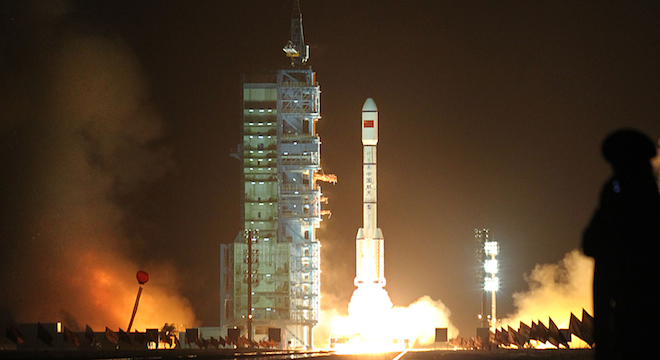China on Thursday successfully launched an unmanned orbital spacecraft that will pave the way for the country’s planned space station.
The Tiangong-1, “Heavenly Palace 1” in English, blasted off at 9:16 pm Beijing time for the Jiuquan Satellite Launch Center in the Mongolian desert as Chinese President Hu Jintao and other officials observed a broadcast of the launch from Beijing, Chinese state news outlet Xinhua reported.
The successful launch is a huge relief to the China National Space Administration, which had delayed the mission after the crash of a Long March II-C rocket on August 19. The rocket is similar in design to the Long March II-F, which carried the Tiangong-1 into orbit. The agency had also feared that bad weather could spoil the launch window, but the takeoff went off without a hitch on a crystal clear night. Check out video below and Xinhua’s image models of the launch procedure.
The 8.5-ton, 34-ft. long Tiangong-1, designed and buily by the China Aerospace Science and Technology Corp, will separate from the Long-March II-F and orbit the earth alone for about one month, conducing orbital tests.
In early November, China will launch the Shenzhou-8 unmanned capsule, which will dock with the Tiangong-1 and remain linked for 12 days.
Over the next two years, China will also send up the Shenzhou-9 and Shenzhou-10 to test the capability of the Tiangong-1 to dock with different craft, including a manned capsule that may carry China’s first female astronaut into orbit, Space.com points out.
Docking is a critical step in being able to assemble disparate modules into a space station, which China hopes to do by 2020. That ambitious goal would make China the third nation in the world to independently create a space station, after the Soviet Union launched its Salyut space station series beginning in 1971 and the United States launched Skylab in 1973.
Still, the China National Space Administration maintains that it will go about its docking tests in a unique and improved fashion from any other space experiment.
“For other countries’ docking processes, one module could only dock with one spacecraft. The Tiangong-1 will eventually dock with three spacecraft, namely the Shenzhou-8, -9 and -10. It will cut costs significantly,” Xinhua reported in advance of the launch.
At the same time, it is important to note that the Tiangong-1 isn’t going to form part of the planned space station itself: It is only a test module that is designed to be decommissioned after two years and piloted back into Earth’s atmosphere, where it will burn up. The actual space station components won’t begin being assembled until 2016.
China is also setting its sights even higher than a space station: It wants to begin exploring the moon with a robotic rover in 2017. Chinese scientists have even claimed that the country could set up a lunar base by 2030.
“Moreover, the [Tiangong] technology can be used for moon landings and deep space exploration though China is only doing concept research and preliminary feasibility studies on manned moon landings, without a timetable,” said Sheng Jie, deputy chief engineer of the Jiuquan Satellite Launch Center, China Daily reported.
As the BBC notes, China’s goals are more than scientific in nature:
China is in the same situation as the US in the 1960s, where the space programme plays a central role in achieving national political and technological goals.
It wants its space successes to reflect China’s ambitions, rather than being shared with other states.
The launch of the Tiangong 1 was timed to coincide with China’s National Day celebrations on Oct. 1, “a period when the eyes of the Chinese nation will be glued to their television screens as the majority will be at home,” China Radio International’s Stuart Wiggin points out.
Despite concerns from foreign policy experts that China could be aiming to weaponize space as well, the country’s space officials have repeatedly sought to assure the international press that the aims of its space program are peaceful.
“The Chinese nation has pursued peace since ancient times,” said Zhou Jianping, chief designer of China’s manned space program, Xinhua reported. “China’s ultimate intention with the space program is to explore space resources and make use of them for mankind’s well-being.”
Check out the launch for yourself in the following video, taken by state TV outlet China Central Television:









